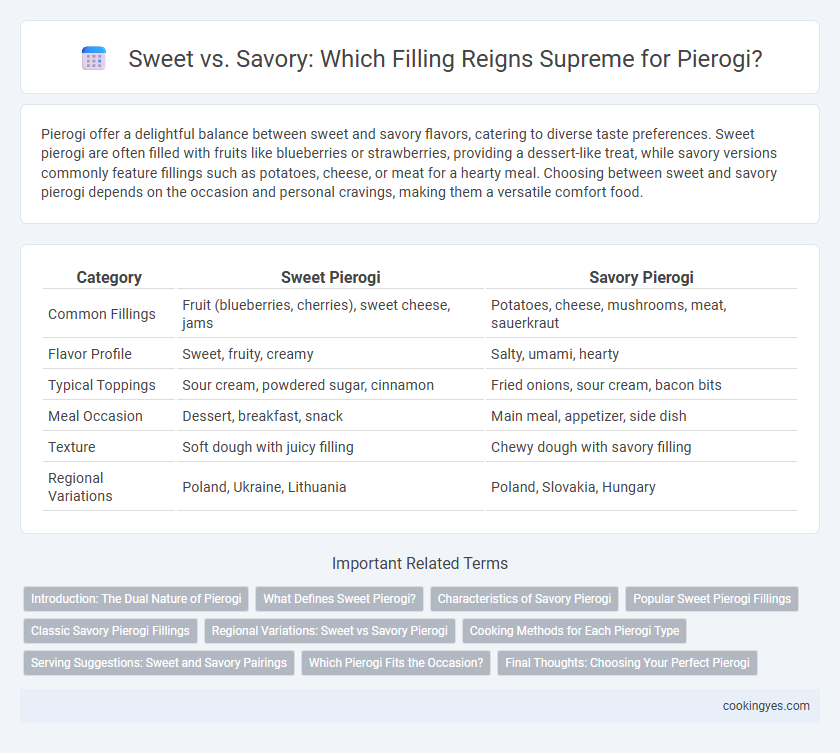Pierogi offer a delightful balance between sweet and savory flavors, catering to diverse taste preferences. Sweet pierogi are often filled with fruits like blueberries or strawberries, providing a dessert-like treat, while savory versions commonly feature fillings such as potatoes, cheese, or meat for a hearty meal. Choosing between sweet and savory pierogi depends on the occasion and personal cravings, making them a versatile comfort food.
Table of Comparison
| Category | Sweet Pierogi | Savory Pierogi |
|---|---|---|
| Common Fillings | Fruit (blueberries, cherries), sweet cheese, jams | Potatoes, cheese, mushrooms, meat, sauerkraut |
| Flavor Profile | Sweet, fruity, creamy | Salty, umami, hearty |
| Typical Toppings | Sour cream, powdered sugar, cinnamon | Fried onions, sour cream, bacon bits |
| Meal Occasion | Dessert, breakfast, snack | Main meal, appetizer, side dish |
| Texture | Soft dough with juicy filling | Chewy dough with savory filling |
| Regional Variations | Poland, Ukraine, Lithuania | Poland, Slovakia, Hungary |
Introduction: The Dual Nature of Pierogi
Pierogi embody a dual culinary identity, offering both sweet and savory variations that cater to diverse palates. Traditional savory fillings include potato, cheese, sauerkraut, and meat, while sweet versions often feature fruits like blueberries or sweet cheese. This versatility highlights pierogi's unique role in blending comfort food with cultural heritage.
What Defines Sweet Pierogi?
Sweet pierogi are defined by their fillings, which typically include fruits such as blueberries, strawberries, or sweetened farmer's cheese, offering a dessert-like experience. These pierogi are often dusted with sugar or served with a dollop of sour cream or sweetened cream to enhance their flavor. The dough remains the same as savory varieties, but the sweetness of the filling distinguishes them in taste and purpose.
Characteristics of Savory Pierogi
Savory pierogi typically feature fillings like mashed potatoes, sauerkraut, ground meat, cheese, or mushrooms, offering a rich and hearty flavor profile. The dough is often boiled and then pan-fried to achieve a crispy exterior with a soft, tender inside, enhancing textural contrast. These pierogi varieties are commonly served with toppings such as sour cream, fried onions, or bacon bits, elevating their savory appeal.
Popular Sweet Pierogi Fillings
Popular sweet pierogi fillings include fresh fruit such as blueberries, strawberries, and cherries, often combined with a touch of sugar or sweetened cream cheese for added richness. Other favorites are sweetened farmer's cheese mixed with vanilla or cinnamon to enhance flavor complexity. These sweet variations offer a delightful contrast to the traditional savory options, appealing to those with a preference for desserts or mild, fruity tastes.
Classic Savory Pierogi Fillings
Classic savory pierogi fillings often feature a combination of potatoes, cheese, and onions, creating a hearty and satisfying flavor profile. Other traditional options include sauerkraut, mushrooms, and ground meat, each offering a distinct taste that reflects Eastern European culinary heritage. These fillings strike a balance of umami and richness, making them popular choices for savory pierogi dishes.
Regional Variations: Sweet vs Savory Pierogi
Regional variations of pierogi highlight distinct preferences between sweet and savory fillings, with Eastern European countries such as Poland favoring savory options like potato, cheese, and sauerkraut, while Eastern Slovakia and Ukraine often feature sweet versions filled with fruits like blueberries or sweetened farmer's cheese. In Poland, savory pierogi with meat or mushrooms dominate traditional meals, whereas sweeter pierogi variants emerge as popular desserts or festive treats. These regional differences reflect cultural tastes and ingredient availability, making pierogi a versatile dish across Central and Eastern Europe.
Cooking Methods for Each Pierogi Type
Sweet pierogi often feature fillings like fruit preserves or sweet cheese and are typically boiled before being lightly sauteed in butter to enhance their tender texture and caramelized flavor. Savory pierogi, filled with ingredients such as potatoes, cheese, mushrooms, or meat, are commonly boiled and then pan-fried to create a crispy outer layer while maintaining a soft, flavorful interior. Both cooking methods optimize the contrast in taste and texture unique to each pierogi type, offering distinct culinary experiences.
Serving Suggestions: Sweet and Savory Pairings
Pierogi pair beautifully with both sweet and savory accompaniments, enhancing their versatile flavor profiles. Savory pierogi fillings such as potato, cheese, or meat are often complemented by toppings like sauteed onions, sour cream, or crispy bacon, creating a rich and hearty meal. Sweet pierogi, filled with fruit or sweet cheese, are best enjoyed with powdered sugar, fruit preserves, or a drizzle of honey for a delightful dessert experience.
Which Pierogi Fits the Occasion?
Savory pierogi, filled with potatoes, cheese, or meat, are ideal for hearty meals and festive gatherings, providing a satisfying and rich flavor profile. Sweet pierogi, often stuffed with fruits like cherries or sweet cheese, are perfect for dessert or lighter occasions, offering a balance of sweetness and tenderness. Choosing between sweet and savory pierogi depends on the event type, with savory fitting main courses and sweet complementing celebratory desserts.
Final Thoughts: Choosing Your Perfect Pierogi
Choosing the perfect pierogi depends on whether you prefer sweet or savory flavors, as both offer unique and satisfying experiences. Sweet pierogi often feature fillings like fruit, sweet cheese, or poppy seeds, providing a delightful dessert option, while savory pierogi include ingredients such as potatoes, sauerkraut, mushrooms, or meat, making them a hearty meal. Understanding your taste preference helps you select the ideal pierogi that perfectly matches your cravings and occasions.
Sweet vs Savory for Pierogi Infographic

 cookingyes.com
cookingyes.com